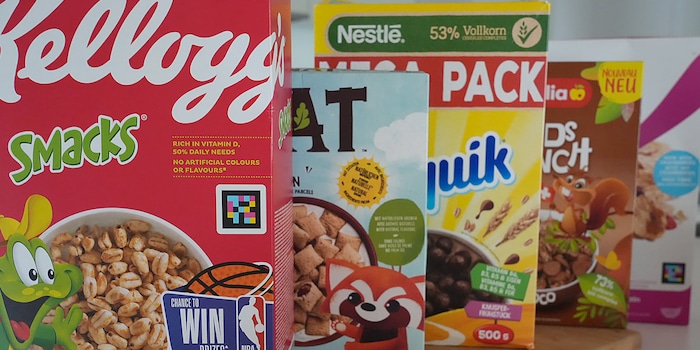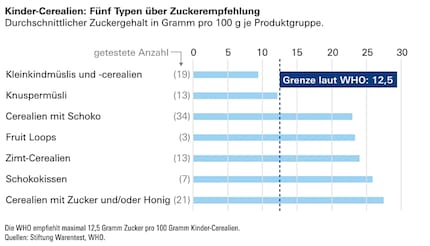
Sugar shock: Stiftung Warentest tests children's cereals - 80 per cent fail
Stiftung Warentest examined 110 children's cereals more closely and found that only 24 are recommended: Just 24 are recommended. The rest exceed the WHO recommendations for sugar - in some cases drastically.
"53 per cent wholegrain", "high in fibre" or "no artificial sweeteners" are emblazoned on cereal packets for children. That sounds good, but it's only half the truth. Most products are miles away from being labelled a "healthy breakfast". This is the damning judgement of Stiftung Warentest.
The German consumer magazine compared the nutritional information of 110 cereal products with the recommendations of the World Health Organisation (WHO). 86 of them exceed the guideline values for sugar, 4 for fat. The WHO defines that 100 grams of cereal should contain a maximum of 12.5 grams of sugar and 17 grams of fat.
The biggest sugar bombs among the sugar bombs
Stiftung Warentest divided the cereals tested into seven groups. The biggest sugar bombs belong to the "honey and sugar cereals" category. First and foremost, Frosties and Smacks from Kellogg's: 100 grams of Kellogg's Frosties, for example, contain 37 grams of sugar per 100 grams. This exceeds the upper limit by almost three times - according to Stiftung Warentest, both Frosties and Smacks are more of a sweet than a meal.
"Chocolate cereals", "chocolate pillows", "cinnamon and sugar cereals" and "fruit loops" are also big sugar traps. All of these groups contain only "not recommended" products. Four of the seven "chocolate pillows" tested - cereals filled with chocolate or nougat cream - even flop twice because they not only contain too much sugar, but also too much fat. Such as the Nat chocolate hazelnut pillows.
Products for toddlers have the least sugar
At least: 24 of the cereals tested are acceptable - all are in the "muesli" or "toddler cereals" categories.

Source: Stiftung Warentest / Isabella Galanty
The mueslis consist mainly of cereal flakes, but are sometimes mixed with sugar and baked into a crunchy muesli. Here, too, parents cannot avoid studying the package inserts: The variation ranges from 6.4 grams of sugar per 100 grams to 28 grams of sugar.
You can't go far wrong with cereals for small children. Almost all products contain only a moderate amount of sugar, with fruit or fruit powder providing the sweetness. Stiftung Warentest recommends that toddler products are also suitable for older children. "A 60 gram portion fills you up well."
Further test findings
But how can it be that some cereals have the best possible Nutri-Score A despite their far too high sugar content? The testers also looked into this question and found that in the calculation model for the Nutri-Score - a scale from A to E that is intended to illustrate the nutritional value - positive fibre can compensate for negative ingredients such as sugar. However, this enrichment is unnecessary, as studies show that children and young people in Germany are already well supplied with nutrients from conventional foods. In addition, the guideline values are different: Nutri-Score tolerates 90 grams of added sugar per day for a person, the WHO only 50 grams.
But there is also good news. Stiftung Warentest last carried out the cereal test in 2008. And since then, the food industry has tended to reduce the amount of sugar in children's cereals somewhat. However, given the high number of overweight children and adolescents worldwide, this is still far from enough.
You can also find healthy alternatives - for children and adults - in our shop. For example, these here:
Cover photo: Katja Fischer
Mom of Anna and Elsa, aperitif expert, group fitness fanatic, aspiring dancer and gossip lover. Often a multitasker and a person who wants it all, sometimes a chocolate chef and queen of the couch.
From the latest iPhone to the return of 80s fashion. The editorial team will help you make sense of it all.
Show all